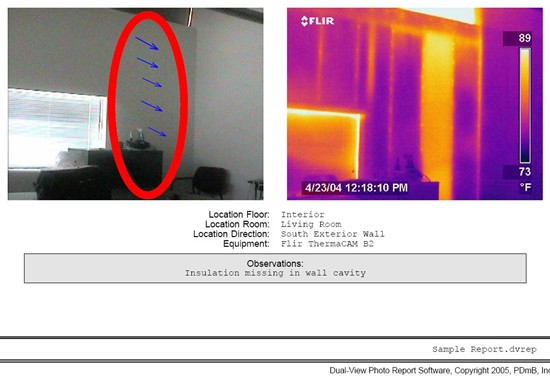From the Battlefield to Home Inspection: Thermal Imaging Creates Waves Throughout the Inspection Industry
The use of thermal imaging and infrared devices is a growing trend. In fact, a 2005 survey conducted by a leading home inspector association shows that just under 9% of home inspectors responding used thermal imaging and infrared devices in their work, a technology that was not even a consideration just three years earlier.
What created this wave? As a science, thermal imaging was originally discovered in the 1800's in Bath, England. It made slow progress until the US Military funded its expansion in the 1950's and 60's. As with everything top secret, access to this technology was limited. As the technology was shared with the public, the typical price of over $20,000 was quite expensive and limited growth. As technology continues to expand, the entry level price for owning a thermal imaging camera has dropped dramatically. An inspector can now purchase a camera in the $7000 range. This much lower entry point and the productive applications that thermal imaging brings to home inspection, have been the impetus of this wave forming. Naturally, more and more inspectors have added thermal imaging services to their home inspection businesses.
Thermal imaging is a non-invasive, non-destructive way of evaluating conditions below the surface. Because everything from faulty wiring to the presence of termites to mold to wet insulation affects the surrounding temperature, heat-sensitive photography can reveal these and other issues that just cannot be seen by the naked eye or with conventional or digital photography. In providing thermal imaging reports you can document a hidden fault for corrective action or to prioritize repairs. For an energy audit you can show exactly where cold air is entering the home or heat is being lost, along with energy dollars. You can also document the safety of a property by revealing dangerous electrical hot spots or the presence of harmful mold. Thermal photography lets you deliver a more thorough and in-depth report to your clients when you can show them what lies beneath the surface.
"I purchased an infra-red camera in 2003 and began to create side by side photo reports of the thermal image and the original digital photo" states Steve Verssen from Vertech, Inc. "My clients immediately saw the value of a thermal imaging report for their home and were more than willing to pay for the additional service. I use the thermal image report to enhance my services and to separate myself from the competition."
In addition to the thermal imaging camera, inspectors will need to consider how to deliver the findings of their inspection to the customer. Inspectors need to realize that the thermal image may be hard for the customer to comprehend or even understand what part of the home is being featured. For this reason, a side by side report that shows the thermal image and a digital photo of the same area is exceptionally valuable to the customer. Inspectors have several software options to choose from when creating a thermal image report.
Many of the thermal imaging cameras include software with the purchase of the camera. Like many things that are free, this type of software is designed for the mass market and not designed specifically for home inspection. The result is that it tends to be a bit complicated and may require multiple steps to create a report. This additional time required by the inspector may diminish the opportunity that thermal imaging presents.
Another option is using your current inspection software. Most high quality programs allow for the insertion of photos. It is important to note that a thermal image is not a digital image. Just because your inspection software accepts digital photos does not ensure that it will accept thermal images. Check with your software vendor before buying a camera. The ease of inserting photos varies greatly between inspection software programs. Inspectors should run a test to see how much time it would take to create a "side by side" comparison format in their current software.
A third option is specially constructed software that allows you to present your infrared and digital findings in a side-by-side photo comparison format. This type of system lets your client see the conventional and thermal views of the areas of concern at the same time and make one note for both photos.

###
Dan Schuerman is a manager with PDmB, Inc. the maker of DUAL-VIEW Photo Report Software which creates side by side thermal imaging reports for the home inspection industry. He can be reached at 888-736-2462 or dans@dualviewsoftware.com. The free Dual-View software demo is available at www.dualviewsoftware.com Mr. Schuerman is a InterNACHI contributing author.
###
